Okunev culture
Okunev culture (ru: Окуневская культура, romanized: Okunevskaya kul'tura, lit. 'Okunev culture'), sometimes also Okunevo culture, was a south Siberian archaeological culture of pastoralists of the early Bronze Age dated from the end of the 3rd millennium BC to the early of the 2nd millennium BC in Minusinsk Basin on the middle and upper Yenisei.[1][2][3] It was formed from the local Neolithic Paleo-Siberian forest cultures, and later received some admixture from a, predominantly male, Late Yamnaya - Early Catacomb population from the North-Western Caspian region, which expanded eastwards to the territory of Southern Siberia.[4][5]
Location of the Okunev culture (Minusinsk Depression), with other contemporary cultures c. -2000 | |
| Alternative names | Okuniev , Okunevskaya |
|---|---|
| Horizon | Indigenous peoples of Siberia |
| Geographical range | Minusinsk Basin South Siberia |
| Period | Bronze Age |
| Dates | c. 2700 BC - 1800 BC |
| Type site | Okunev settlement |
| Major sites | Tas-Khaaza, Chernovaya VIII, Beltyry, Uibat III, Uibat V |
| Characteristics | unique artistic heritage |
| Preceded by | Afanasevo culture |
| Followed by | Karasuk culture, Andronovo culture, Tagar culture |
History
The Okunev culture was discovered by Sergei Teploukhov in 1928. It was named after the nearby Okunev settlement in southern modern Khakassia. Initially, the burials from Okunev were attributed by S. A. Teploukhov to the Andronovo culture. Then on the basis of vessel finds Teploukhov considered the population to be a transitional variant between the Afanasievo and Andronovo cultures.
In 1947, M. N. Komarova singled out the sites in the early Okunev stage of the Andronovo culture.
In 1955-1957 A.N. Lipsky found Okunev stone slabs with images as part of stone boxes in which burials were made. Lipsky, who was an ethnographer not an archaeologist, assumed that the Okunev sites were pre-Afanasiev and attributed them to the Paleolithic era, since he considered the Okunev people to be the ancestors of the American Paleo-Indians, based on parallels in art and anthropology.
In the early 1960s G. A. Maksimenkov identified an Okunev culture based on the excavations of the Chernovaya VIII burial ground, whose burials were not disturbed by later invasions and did not contain Afanasevo ceramics.
Characteristics
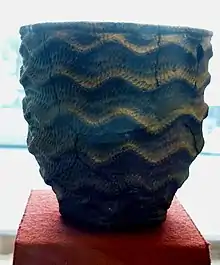
Differentiate early Uibat stage, later Chernov stage, final Razliv stage in Okunev culture.
Typical sites of Tas-Khaaz, Beltyry, Uibat III, Uibat V (on Uybat river basin), Chernovaya VIII, Chernovaya XI, Razliv X, Strelka.
The typological horizon between the development of the Afanas’ev and Okunev steppe cultures in the Minusinsk Basin and the development of the later Andronovo type is very thin.[6]
Finds from the Okunev culture include works of art, which included stone statues with human faces (Tas Khyz, as well as Ulug Khurtuyakh tas) and images of birds and beasts hammered out on stone slabs or engraved on bone plaques.
There were no significant indications of property and social stratification.
Livestock, horse, and agriculture
The basis of the population's economic activity was stock-raising and animal husbandry (cattle, sheep, and goats), supplemented by hunting and fishing.
Stone hoes, grain graters and pestles, and a reaping sickle (copper blade, horn handle) testify to agriculture.
Pottery
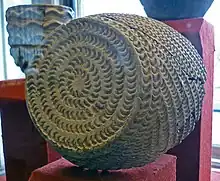
Though the ceramic styles of the Okunev are more comparable to later Incised Coarse Ware (ICW), formally and ambiguously Andronovo ceramics.[6] But as the researchers note, the uniqueness of each of them is an important feature of the Okunev culture.[7] Finds from the Okunev culture include lavishly decorated jug-like and conical vessels.
Okunev ceramics are typically flat-bottomed, with notable continuous ornamentation of the body, the bottom, edge of the rim and its inner side. Most often these are jar vessels, but there are also incense burners with an internal partition.
Metallurgy
Okunevtsy had developed metallurgy based on the ores of the Sayano-Altai Mining and Metallurgy areas. Okunevtsy and their neighboring Samus' produced the first in bronze in north-eastern Central Asia.[8] Finds include copper and tin (rarely arsenic) bronze articles. Simple copper objects were superseded by tin alloys.[8] Bronzes are common in this culture. Tools include embedded-handled knives, leaf-shaped knives, awls, fishhooks, and temporal rings. Along with forging, casting was also used, which indicates a rather high level of metalworking. Ornaments of this culture consist mainly of ring-shaped ornaments with circular cross-sections and flat joints at both ends.[9]
Warfare
Short swords are relatively advanced with clear boundaries between the handles and the blades. A bronze spear was found at the late Okunevo cultural site, the socket of which was forged with two loose ends. The first of this kind appeared in the Asian steppe region.[9]
Burials
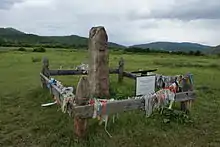

The Okunevo culture is represented mostly by mounds burial structures, which were composed of small, rectangular surface enclosures made of stone slabs or sandstone tiles placed vertically in the ground. Within these enclosures were graves that were also lined with stone slabs. 62 Okunevo kurgans consisting of more than 500 burials and 60 single burials have been studied.[10]
The cemeteries of the Okunev culture are located, as a rule, not far from the Afanasiev ones and number from 2 to 10 burial mounds. Sometimes there are burial complexes measuring 40 × 40 meters. The number of graves inside the fence varies - from 1 to 10 and even 20. In addition to single burials, there are paired and collective burials. In almost every burial ground there are burials of a man with two women. The buried were laid, as in Afanasiev's time, on their backs with legs strongly bent at the knees and arms extended along the body.
Dating
Radiocarbon AMS dating of 50 Okunevo samples are within 2600 –1800 BCE. According to these studies the Uybat period is dated as 2600 – 2300 BCE, Chernovaya as 2200 – 1900 BCE, and Razliv later than 1800 BC.[10]
Geographic extent
The settlements of the Okunev culture were located in the Minusinsk basin, on the middle and upper Yenisei.
In the narrow mountain valleys of Khyzyl Khaya and Khurtuy Khola, on the banks of now dry streams, on the modern territory of the Kazanovka Museum-Reserve, where petroglyphs of the Okunev period are located.
On the right bank of the Tuba River, the right tributary of the Yenisei, against the village of Tes to the southeast of the village of Ilyinka between the logs and the Shush River to the southwest of the village of Shalabolino, Kuraginsky District, Krasnoyarsk Krai, there is the Shalabolino Petroglyphs, where the Okunev rock art monuments are also represented.
In the Idrinsky district, east of the village of Bolshoi Telek.

In the Krasnoturansky District on the left bank of the Bir River under Mount Kozlikha, on the banks of the Syda River.
In the Kuraginsky district in the village of Novopokrovka.
In the Minusinsky District, on the banks of the Tuba River, near the village of Kavkazsky, nearby the zaimka of Maidashi.
On the shore of the lake near the village of the same name Maly Kyzykul, during excavations in the Okunev layer, archaeologists in 1973 discovered the remains of a burnt log structure and fragments of ceramic dishes.
Five burials in slab boxes were excavated 1 km south of Minusinsk on the northern outskirts of a pine forest.
Related cultures
Okunev culture shares some elements of its material culture including pottery with a number of local contemporaneous cultures from adjacent areas such as the Samus’, Elunino, Karacol, and Krotovo cultures of western Siberia and Altai, the Kanay type burials of eastern Kazakhstan, and the Okunevo-like culture of Tuva.[10] Nevertheless, there is currently no sound evidence of the common origins of it.
The connections between the Afanasiev and Okunev cultures are rather difficult to trace. The period of their interaction lasted only about a hundred years,[3] in some territories coexistence is noted. Archaeologists have identified many complexes containing signs of both Okunev and Afanasevo origins. However, almost no genetic traces of Afanasevtsy in the Okunev genotype have been found, meaning Afanasiev population was displaced by the alien Okunevtsy.
The similarity between some of the objects from the Okunev burial grounds and objects found in sites in the vicinity of the middle Ob River and the Lake Baikal region indicates that the bearers of the Okunev culture came to southern Siberia from the northern taiga regions. While the preceding Afanasevo culture is considered Indo-European, the Okunev culture is generally regarded as an extension of the local non-Indo-European forest culture into the region.[11]
The Okunev people closely interacted with [12] succeeded cultures of the Andronovo circle.[1]
Settlements
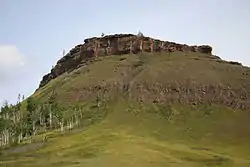
The settlements of this culture have been little studied. Mountain Fortress Sve [13] mountain settlements with fortifications (about 45 were found on the territory of Khakassia) are considered mainly as cult complexes. The fortress of Chebaki is one of the first archeologically studied Sve.
Settlements are known on the territory of Tuva on upper Yenisei.
Wheeled transport
The Okunev people used two- and four-wheeled carts. In the rock art of the Minusinsk Basin, images of early (end of the 3rd millennium BC) two-wheeled carts with a composite drawbar of two poles converging at an angle, which simultaneously form the body frame, are common. The design of the wagons and the profile manner of depiction indicate a connection not with Eastern Europe, but with the western regions of Central Asia and, indirectly, with Asia Minor.[14]
Physical anthropology

The anthropological type of the population was of mixed Caucasoid-Mongoloid origin, with a predominance of Mongoloid. As A. V. Gromov notes, their morphological heterogeneity was striking - there are both purely Mongoloid skulls and typically Caucasoid ones that do not reveal any traces of Mongoloid admixture. In his opinion, the appearance of the Okunev people was formed as a result of the mixing of the local Neolithic population with influx of Afanasyevtsy from the territory of Central Asia and Kazakhstan.[15]
According to A. G. Kozintsev, the appearance of the Okunev people varies depending on the region. The Okunev people of the Minusinsk Basin were the descendants of the local Neolithic population, which was distinguished by its significant originality against the background of the races of the first order. The Okunev people of Tuva show stronger influence from the Pits culture and early Catacomb culture of Ukraine.[16] He argues that the main ancestry of the Okunev people can be traced back to the Ancient North Eurasians and that the anthropologic type of the Okunev people can be described as "Americanoid", noting the specific overlaps in characteristics with the Indigenous peoples of the Americas.[17]
According to A. V. Polyakov, the culture was formed from the local Neolithic Paleo-Siberian forest cultures and later received some admixture from the Caspian Sea by a group of mostly male pastoralists of the Yamnaya culture.[18]
While some authors have suggested that the Okunevo may have descended from more northern tribes that replaced Afanasievo cultures in this region, others believe the Okunevo culture was the result of contact between local Neolithic hunter-gatherers with western pastoralists.[10]
Maksimentkov suggested that Okunevo culture was developed by the local Neolithic tribes of the Krasnoyarsk - Kansk forest-steppe who lived to the north of the Minusinsk Basin.
The second theory that is supported at the present time by most researchers suggests that Okunevo culture resulted from the interaction of local Neolithic hunter-gatherers with Western cattle breeders.
_1.jpg.webp) Okunev figurine from Itkul II mound 14, northern Minusinsk Basin. Uybat stage of the Okunevo Culture (second half of the 3rd millennium BC)
Okunev figurine from Itkul II mound 14, northern Minusinsk Basin. Uybat stage of the Okunevo Culture (second half of the 3rd millennium BC)_2.jpg.webp) Okunev figurine from Itkul II mound 14, northern Minusinsk Basin.
Okunev figurine from Itkul II mound 14, northern Minusinsk Basin._3.jpg.webp) Okunev figurine from Itkul II mound 14, northern Minusinsk Basin.
Okunev figurine from Itkul II mound 14, northern Minusinsk Basin._4.jpg.webp) Okunev figurine from Itkul II mound 14, northern Minusinsk Basin.
Okunev figurine from Itkul II mound 14, northern Minusinsk Basin.
Paleogenetics
Autosomal DNA analysis found that the Okunevo people formed predominantly from a lineage closely related to Paleolithic Siberians (Ancient North Eurasian) with admixture from Neo-Siberians. The date of admixture is estimated to around 7,000 years ago. Representatives of the Okunev culture are dominated by the Y-chromosomal haplogroup Q1a (subcladeas Q1a1b1, Q1a2a1c, Q1a2b), followed by haplogroup NO(xO), presumably Haplogroup N-M231. In one representative of the Okunev culture, the subclade R1b1a2-M269 of the Y-chromosomal haplogroup R1b was identified.[21] In the RISE664 sample (4409–4156 years ago, Okunevo_EMBA), the Y-chromosomal haplogroup Q1b1a3a1~-Y18330* was identified. The Y-chromosomal haplogroup Q1b2b1~-Y2679* [22] and the mitochondrial haplogroup A-a1b3* [23][24] were identified in the RISE674 sample (4300–3850 years ago, Okunevo_EMBA). In representatives of the Okunev culture from the burial ground of Syda V (Minusinsk Basin), a variety of mitochondrial DNA variants was determined.[25] The Okunevs belonged to the West Eurasian (U, H, J and T) and East Eurasian (A, C and D) subbranches of haplogroups.[26][21]
The results of the analysis of the origin of the ancient steppe populations of nomads of the Eurasian steppe (from the Urals to Altai), including representatives of the Bronze Age Okunev culture from the Sayan-Altai, showed that the samples contained components that were most pronounced in Ancient North Eurasian, Eastern hunter-gatherers, Caucasian hunter-gatherers from Georgia and also occur from the component that is most pronounced among the Nganasans (Samoyedic people) and is widely distributed among various modern people from Siberia and Central Asia. Among the earlier steppe inhabitants, the hereditary component, which is most pronounced in the populations of East Asia, occurs in trace amounts. Haplogroup N-M231, which has been introduced into Okunevo-related populations from geneflow from further East, and later spreaded as part of the Seima-Turbino phenomenon.[28][29]
According to recent studies, modern Native American Indians are genetically close to representatives of the Okunev culture, which confirms previous craniometric studies. Their common ancestors probably come from the population of the Late Paleolithic from the cluster of hunter-gatherers Malta (Mal'ta Cluster) (sites of the Mal'ta–Buret' culture in the Baikal region and Afontova Gora in Krasnoyarsk).[30]
The Okunevo population showed high genetic affinities with the Botai culture, some of the Tarim mummies, and Altai hunter-gatherers, and may be ancestral to Uralic-speaking populations.[29]
Art
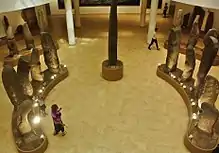
Representative art: small amulets, stone steles up to 4 m tall and petroglyphs.[8]
The Okunev people left behind wonderful monuments of art. Characteristic rock inscriptions and stone statues have become famous since the travels of D. G. Messerschmidt in 1722-1723 and subsequent Academic expeditions. Steles with drawings from burial vaults are unique. The stone slabs are dominated by realistic images of animals and masks in headdresses, which apparently had a cult character. Rock art monuments are being studied and new ones are being discovered that were not studied by previous researchers.[31][32] Menhirs are common in the territory of modern Khakassia and the southern part of the Krasnoyarsk Krai. More than 300 of them have been explored on the territory of the Minusinsk Basin. Only 10 sites are known on the right bank of the Yenisei.
The impressive stone steles were originally erected at gravesites and were subsequently reused more thean millennium later in the Scythian-era kurgans of Tagar Culture.[8]
Okunev stone stelas collection displayed in the Khakass National Museum of Local Lore in Abakan, Martyanov Museum in Minusinsk,[33] Historical and architectural open-air museum of Novosibirsk and ceramics collection displayed in Hermitage Museum in Saint Petersburg.[34]
Anthropomorphic images
The vivid character of the art of the Okunev culture is created by monumental stone sculptures and steles with anthropomorphic images carved on them. The statue is usually a tall stone reaching up to 6 meters in height (sandstone or granite) of a saber shape. The front is its narrow edge. More than 300 of them have been studied on the territory of the Minusinsk Basin, only 10 monuments are known on the right bank of the Yenisei river. Many of them are displayed now in Museums.[37] A fantastic mask looks at the viewer from it: three eyes, nostrils, a huge mouth, horns, long ears and all kinds of processes. The image moves from the front face to the wide side, and sometimes to the back. In addition to the central mask, there are often additional, smaller ones. Sometimes the statue depicts the mouth of a predator, sometimes bulls, many so-called solar symbols. They come in different styles, but usually it is a circle inscribed in a square, a kind of mandala, a symbol of the cosmos. This sign as an official symbol is placed both on the state flag and on the state emblem of modern Khakassia. It was discussed that vertical steles might be used as the ancient tool of orientation in space - time milestones and gnomons - sundial of solar hours calendars. A graphical drawing of vertical sundial can be seen in the divergent rays on sun-faced stele, where the tooth is a benchmark for accurate determination of the noon.
 Tourist-2 ivory anthropomorphic figure
Tourist-2 ivory anthropomorphic figure Tourist-2 mammoth ivory anthropomorphic figure
Tourist-2 mammoth ivory anthropomorphic figure![A monument of Okunev art sketched by Aspelin's expedition, 1887, currently[when?] displayed in Martyanov Museum in Minusinsk](../I/%D0%98%D0%B7_Alt-Altaische.png.webp)
Artistic features of images
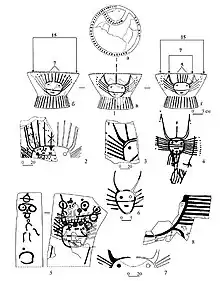
The following artistic features are distinguished:
- free scatter of figures in the pictorial field;
- the presence of anthropomorphic masks;
- elongated proportions of stylized figures;
- a variety of fantastic animals;
- anthropomorphic creatures with bird and animal heads;
- the sacred (world) mountain in the form of a triangle, divided into parts;
- triadic compositions, in which the image of a female deity or its symbol is flanked by two figures of a person or animal;
- images of deities in pointed hats and with bull horns;
- images of Janus anthropomorphic deities;
- images of anthropomorphic figures with two eagle heads;
- images of birds and ornithomorphic figures with a spiral "tuft" on their heads;
- figures of a man with legs and head turned in profile, and the body in front;
- images of characters under the arch of the "firmament";
- solar sign.
Similarities have been noted between the geometrical anthropomorphic motifs of the Afanasievo culture and Okunev culture of the Minusinsk basin in Siberia, and those on the earlier potteries of Banpo (c. 4000 BCE), of the Yangshao culture in northern China.[38] Pottery style emerging from the Yangshao culture are known to have spread westward to the Majiayao culture, and then further to Xinjiang and Central Asia.[39]
Ethnolinguistic affiliation
The Okunev culture population may be associated with the Proto-Uralic speakers and showed genetic affinity with the earlier Botai culture and the Tarim mummies, both having high amounts of Ancient North Eurasian ancestry. The "eastern" genetic components may have resulted from areal contact with Proto-Turkic peoples.[29] Peyrot argues that the Okunevo culture is either to be associated with Proto-Samoyedic or Proto-Uralic, stating that "the Okunevo Culture is not to be identified with early Samoyedic, but with Proto-Uralic. This is consistent with Janhunen’s convincing arguments that the Ural-Altaic typological profile of Uralic and the primary split between Samoyedic and Finno-Ugric point to an eastern origin (2001; 2009), and it would be just in time for Finno-Ugric to split off and move west towards the Ural Mountains, where this branch was influenced by Proto-Indo-Iranian (e.g. Kuz’mina 2001)."[40]
References
Citations
- "Okunev Culture". The Great Soviet Encyclopedia. 1979. Retrieved March 13, 2015.
- Svyatko, S.V. (2009). "New radiocarbon dates and a review of the chronology of prehistoric populations from the Minusinsk basin, Southern Siberia, Russia". Radiocarbon. 51 №1: 243–273. doi:10.1017/S0033822200033798. S2CID 129736828.
- Poliakov, A.V. (2022). Chronology and cultural genesis of the Paleometal epoch sites in Minusinsk basins (in Russian). St. Petersburg: Neva printing house. ISBN 978-5-907298-32-3.
- Лазаретов, И. П. (2019-12-22). "ХроноЛоГИЯ И Периодизация Окуневкой Културы: Современное Состяние И Перспективы" [Chronology and Periodization of the Okunev Culture: Current Status and Prospects]. Теория и практика археологических исследований (in Russian). 28 (4): 15–50. doi:10.14258/tpai(2019)4(28).-02. ISSN 2712-8202. S2CID 213334623.
- Kozintsev, A. G. (2020-12-31). "The Origin of the Okunev Population, Southern Siberia: The Evidence of Physical Anthropology and Genetics". Archaeology, Ethnology & Anthropology of Eurasia. 48 (4): 135–145. doi:10.17746/1563-0110.2020.48.4.135-145. ISSN 1563-0110.
- Frachetti, Michael (2002). "10. Bronze Age Exploitation and Political Dynamics of the Eastern Eurasian Steppe Zone". Ancient interactions : east and west in Eurasia. Katherine V. Boyle, Colin Renfrew, Marsha Levine, McDonald Institute for Archaeological Research. Cambridge [United Kingdom]: McDonald Institute for Archaeological Research, University of Cambridge. ISBN 1-902937-19-8. OCLC 52221476.
- Poliakov, Andrey (2020). "Поляков А.В. К вопросу об особенностях памятников окуневского типа Верхнего Енисея // Древние и средневековые культуры Центральной Азии (становление, развитие и взаимодействие урбанизированных и скотоводческих обществ). – СПб.: ИИМК РАН – C. 93–96" [On the question of the features of the monuments of the Okunev type of the Upper Yenisei // Ancient and medieval cultures of Central Asia (formation, development and interaction of urbanized and pastoral societies).]. St.Petersburg.
{{cite journal}}: Cite journal requires|journal=(help) - Baumer, Christoph (2018-04-18). History of Central Asia, The: 4-volume set. Bloomsbury Publishing. ISBN 978-1-83860-868-2.
- Yang, Jianhua; Shao, Huiqiu; Pan, Ling (2020-01-03). The Metal Road of the Eastern Eurasian Steppe: The Formation of the Xiongnu Confederation and the Silk Road. Springer Nature. ISBN 978-981-329-155-3.
- Outram, Alan K.; Polyakov, Andrey; Gromov, Andrei; Moiseyev, Vyacheslav; Weber, Andrzej W.; Bazaliiskii, Vladimir I.; O. I. Goriunova (2018-05-09). "Archaeological Supplement B To Damgaard Et Al. 2018: Discussion Of The Archaeology Of Central Asian And East Asian Neolithic To Bronze Age Hunter-Gatherers And Early Pastoralists, Including Consideration Of Horse Domestication" [ANDRONOVO ORNAMENT (MORPHOLOGY AND MYTHOLOGY) I.V. KOVTUN ANDRONOV ORNAMENT (MORPHOLOGY AND MYTHOLOGY)] (in Russian). doi:10.5281/ZENODO.1240521. S2CID 165645181.
{{cite journal}}: Cite journal requires|journal=(help) - Mallory 1997, pp. 4–6
- Kovtun, Igor. И.В. Ковтун Андроновский Орнамент (Морфология И Мифология) [Andronovo Ornament (Morphology and Mythology)]. ISBN 9785990913103.
- "Окуневская Кулътура • Большая российская энциклопедия - электронная версия" [Okunevskaya Culture • Great Russian encyclopedia - electronic version]. bigenc.ru. Retrieved 2022-12-14.
- Esin, Yury N. "The Most Ancient Images of Wheeled Vehicles of Minusinsk Basin". American Journal of Archaeology.
- "Окуневский сборник, 1997". kronk.spb.ru. Retrieved 2022-12-14.
- Kozintsev, A. G (2018-06-21). "On the early migrations of Caucasoids to Siberia and Central Asia (in connection with the Indo-European problem). Archival copy of June 21, 2018 at the Wayback Machine Archeology, Ethnography and Anthropology of Eurasia. 2009. No. 4 (40). S. 134" (PDF). Archived from the original (PDF) on 2018-06-21. Retrieved 2022-12-14.
- Kozintsev, A. G. (2020-12-31). "The Origin of the Okunev Population, Southern Siberia: The Evidence of Physical Anthropology and Genetics". Archaeology, Ethnology & Anthropology of Eurasia. 48 (4): 135–145. doi:10.17746/1563-0110.2020.48.4.135-145. ISSN 1563-0110.
- Poliakov, Andrey. "Поляков А.В. Проблема сложения окуневской культуры в свете современных научных данных // Научное обозрение Саяно-Алтая. – 2020. – № 1 (25). – С. 3–6" [The problem of the formation of the Okunev culture in the light of modern scientific data].
{{cite journal}}: Cite journal requires|journal=(help) - Unterländer, Martina; Palstra, Friso; Lazaridis, Iosif; Pilipenko, Aleksandr; Hofmanová, Zuzana; Groß, Melanie; Sell, Christian; Blöcher, Jens; Kirsanow, Karola; Rohland, Nadin; Rieger, Benjamin (2017-03-03). "Ancestry and demography and descendants of Iron Age nomads of the Eurasian Steppe". Nature Communications. 8: Figure 7. doi:10.1038/ncomms14615. ISSN 2041-1723. PMC 5337992. PMID 28256537.
- Unterländer, Martina; Palstra, Friso; Lazaridis, Iosif; Pilipenko, Aleksandr; Hofmanová, Zuzana; Groß, Melanie; Sell, Christian; Blöcher, Jens; Kirsanow, Karola; Rohland, Nadin; Rieger, Benjamin (2017-03-03). "Ancestry and demography and descendants of Iron Age nomads of the Eurasian Steppe". Nature Communications. 8: Figure 7. doi:10.1038/ncomms14615. ISSN 2041-1723. PMC 5337992. PMID 28256537.
- Hollard, Clémence; Zvénigorosky, Vincent; Kovalev, Alexey; Kiryushin, Yurii; Tishkin, Alexey; Lazaretov, Igor; Crubézy, Eric; Ludes, Bertrand; Keyser, Christine (September 2018). "New genetic evidence of affinities and discontinuities between bronze age Siberian populations". American Journal of Physical Anthropology. 167 (1): 97–107. doi:10.1002/ajpa.23607. PMID 29900529. S2CID 205337212.
- "Q-Y2679 YTree". www.yfull.com. Retrieved 2022-12-14.
- de Barros Damgaard, Peter; Martiniano, Rui; Kamm, Jack; Moreno-Mayar, J. Víctor; Kroonen, Guus; Peyrot, Michaël; Barjamovic, Gojko; Rasmussen, Simon; Zacho, Claus; Baimukhanov, Nurbol; Zaibert, Victor; Merz, Victor; Biddanda, Arjun; Merz, Ilja; Loman, Valeriy (2018-06-29). "The first horse herders and the impact of early Bronze Age steppe expansions into Asia". Science. 360 (6396): eaar7711. doi:10.1126/science.aar7711. ISSN 0036-8075. PMC 6748862. PMID 29743352.
- "A-a1b3 MTree". www.yfull.com. Retrieved 2022-12-14.
- Пилипенко, И. В.; Пристяжнюк, М. С.; Трапезов, Р. О.; Черданцев, С. В.; Молодин, В. И.; Пилипенко, А. С. (2022-09-08). "Разнообразие вариантов митохондриальной ДНК у носителей окуневской культуры из могильника Сыда V (Минусинская котловина)" [Diversity of Mitochondrial DNA Variants in Okunev Culture Carriers from the Syda V Burial Ground (Minusinsk Basin)]. Вестник Новосибирского государственного университета. Серия: История, филология (in Russian). 21 (7): 53–71. doi:10.25205/1818-7919-2022-21-7-53-71. ISSN 1818-7919. S2CID 252230589.
- "Афанасьевская и окуневская археологические культуры Южной Сибири генетически различны | Генофонд РФ" [Afanasyevskaya and Okunevskaya archaeological cultures of South Siberia are genetically different | RF gene pool] (in Russian). Retrieved 2022-12-21.
- Pilipenko, Aleksandr S. (20 September 2018). "Maternal genetic features of the Iron Age Tagar population from Southern Siberia (1st millennium BC)". PLOS ONE. 13 (9): e0204062. doi:10.1371/journal.pone.0204062. ISSN 1932-6203.
- Unterländer, Martina; Palstra, Friso; Lazaridis, Iosif; Pilipenko, Aleksandr; Hofmanová, Zuzana; Groß, Melanie; Sell, Christian; Blöcher, Jens; Kirsanow, Karola; Rohland, Nadin; Rieger, Benjamin; Kaiser, Elke; Schier, Wolfram; Pozdniakov, Dimitri; Khokhlov, Aleksandr (2017-03-03). "Ancestry and demography and descendants of Iron Age nomads of the Eurasian Steppe". Nature Communications. 8: 14615. doi:10.1038/ncomms14615. ISSN 2041-1723. PMC 5337992. PMID 28256537.
- Bjørn, Rasmus G. (2022). "Indo-European loanwords and exchange in Bronze Age Central and East Asia: Six new perspectives on prehistoric exchange in the Eastern Steppe Zone". Evolutionary Human Sciences. 4: e23. doi:10.1017/ehs.2022.16. ISSN 2513-843X. S2CID 248358873.
- Kozintsev, A. G. (2020-12-31). "The Origin of the Okunev Population, Southern Siberia: The Evidence of Physical Anthropology and Genetics". Archaeology, Ethnology & Anthropology of Eurasia. 48 (4): 135–145. doi:10.17746/1563-0110.2020.48.4.135-145. ISSN 1563-0110.
- Miklashevich, Е. А. (2022-04-02). "Личины Моховского Лога и памятники окуневской культуры в горах Оглахты" [The faces of the Mokhovsky Log and monuments of the Okunev culture in the mountains of Oglakhty]. Теория и практика археологических исследований (in Russian). 34 (1): 47–74. doi:10.14258/tpai(2022)34(1).-03. ISSN 2712-8202. S2CID 248362290.
- Miklashevich, Е. А. (2022-09-27). "New Rock Art Site at the Riverside Cliff s in the Oglakhty Mountains (Khakasia)". Теория и практика археологических исследований. 34 (3): 40–54. doi:10.14258/tpai(2022)34(3).-03. ISSN 2712-8202. S2CID 252687323.
- "Martyanov Museum. Minusinsk". Retrieved 2022-12-15.
- "Черепки от стенок окуневских сосудов, сплошь орнаментированные - Четыре пер. пол. I тыс. до н.э." [Sherds from the walls of Okunev vessels, entirely ornamented - Four, first half of the 1st millennium BC.]. collections.hermitage.ru (in Russian). Retrieved 2022-12-19.
- Ковтун, И. В. (24 September 2019). "THE MOON IN THE MYTHOLOGY OF CULTURES OF THE EPOCHE OF BRONZE IN NORTH-WESTERN ASIA (the 3rd – beginning of the 2nd) ЛУНА В МИФОЛОГИИ КУЛЬТУР ЭПОХИ БРОНЗЫ СЕВЕРО-ЗАПАДНОЙ АЗИИ (III – нач. II тыс. до н.э.)". Theory and Practice of Archaeological Research Теория и практика археологических исследований (in Russian). 27 (3): 66–101. doi:10.14258/tpai(2019)3(27).-06. ISSN 2712-8202.
- Zotkina, L. V.; Basova, N. V.; Postnov, A. V.; Kolobova, K. A. (31 December 2020). "An Elk Figurine from Tourist-2, Novosibirsk: Technological and Stylistic Features". Archaeology, Ethnology & Anthropology of Eurasia. 48 (4): 75. doi:10.17746/1563-0110.2020.48.4.075-083. ISSN 1563-0110.
- "A figure of the "Solar Divine" (a stele)". nav.shm.ru. Retrieved 2022-12-14.
- Kiselov (Киселёв), С.В. (1962). Study of the Minusinsk stone sculptures (К изучению минусинских каменных изваяний). Historical and archaeological collection ( Историко-археологический сборник). pp. 53–61.
During the excavations of the world-famous Yanshao [Yangshao] culture site near the village of Banpo near Xi'an, among numerous painted vessels, two large open bowls with paintings were found, especially important for comparison with images of masks from the Minusinsk-Khakass basin. Inside these bowls are painted masks that are strikingly similar to Minusinsk ones. They are distinguished by a horizontal division of the face into three zones, the presence of horns and a triangular figure above the head, as well as triangles on the chin (Fig. 2 ). Such coincidences can hardly be explained by mere chance. Even a few years before the discoveries in Ban-po, I had to pay attention to a number of features that bring the Eneolithic Afanasiev culture of the middle Yenisei closer to the culture of painted ceramics of Northern China. Apparently, the finds in Ban-po once again confirm these observations. At the same time, the noted finds and comparisons show that the appearance of images, so characteristic of the ancient stone sculptures of the middle Yenisei, not only goes back to the deep antiquity of the pre-Afanasiev time, but is apparently associated with the complex world of symbolic images of the Far East, now known from monuments of the Neolithic of Ancient China.
- Zhang, Kai (4 February 2021). "The Spread and Integration of Painted pottery Art along the Silk Road" (PDF). Region - Educational Research and Reviews. 3 (1): 18. doi:10.32629/RERR.V3I1.242.
The early cultural exchanges between the East and the West are mainly reflected in several aspects: first, in the late Neolithic period of painted pottery culture, the Yangshao culture (5000-3000 BC) from the Central Plains spread westward, which had a great impact on Majiayao culture (3000-2000 BC), and then continued to spread to Xinjiang and Central Asia through the transition of Hexi corridor
- Peyrot, Michaël (2019-12-02). "The deviant typological profile of the Tocharian branch of Indo-European may be due to Uralic substrate influence". Indo-European Linguistics. 7 (1): 72–121. doi:10.1163/22125892-00701007. ISSN 2212-5884.
Sources
- Mallory, J. P. (1997). Encyclopedia of Indo-European Culture. Taylor & Francis. ISBN 1884964982. Retrieved March 13, 2015.
.png.webp)
.jpg.webp)


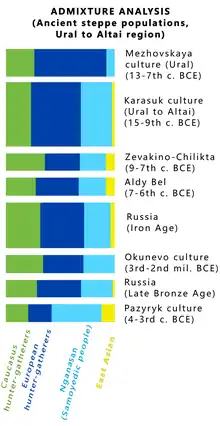
_based_on_mtDNA_HVRI_sequences_in_the_Tagar_series_and_other_ancient_populations_from_different_regions_of_Eurasia.jpg.webp)

